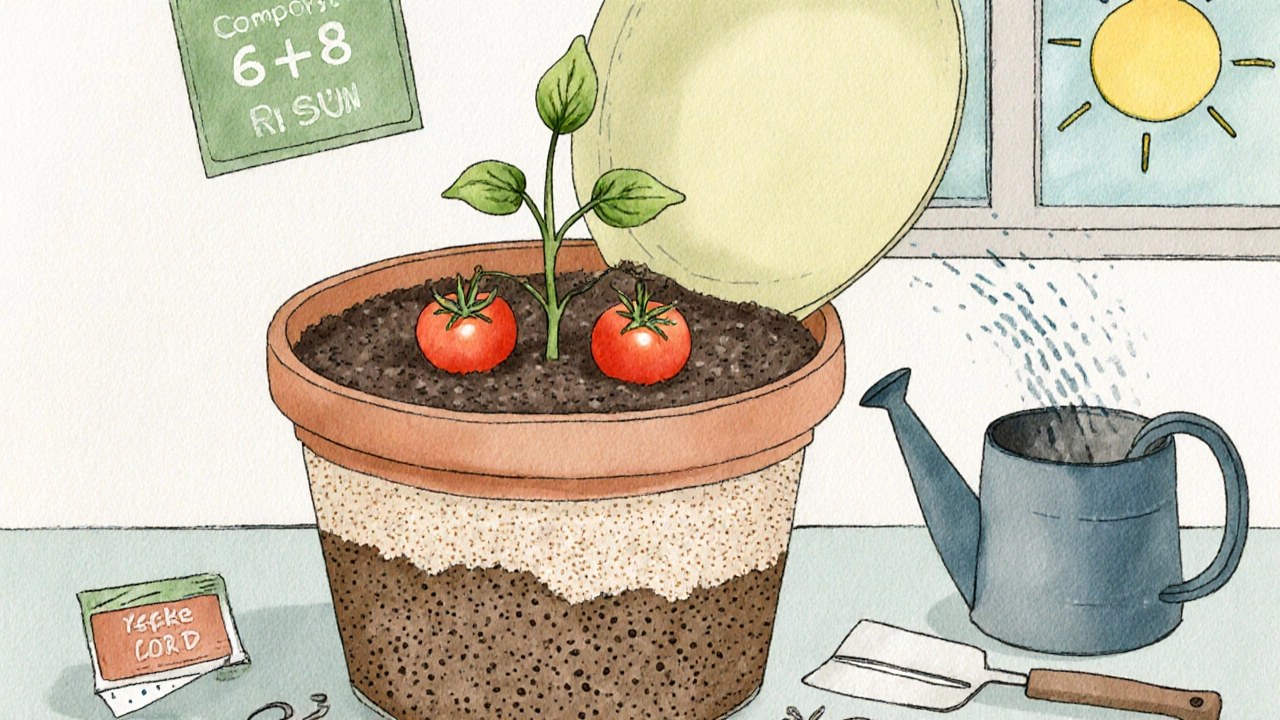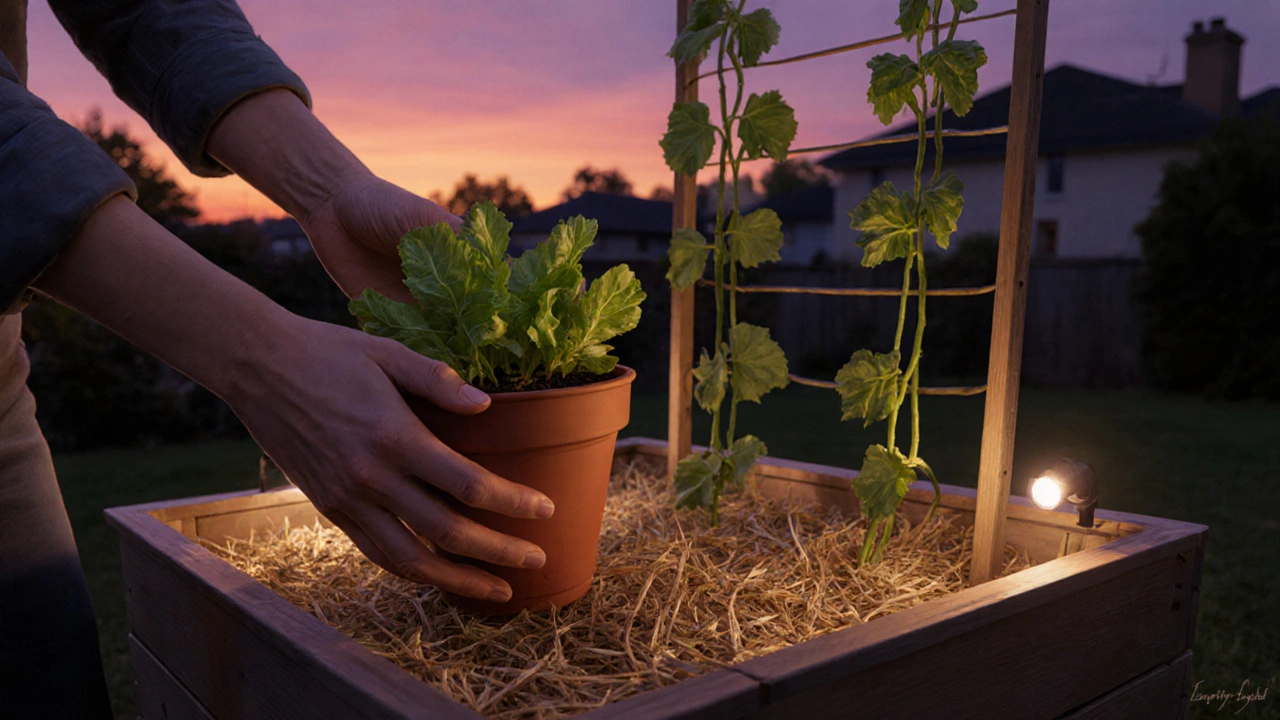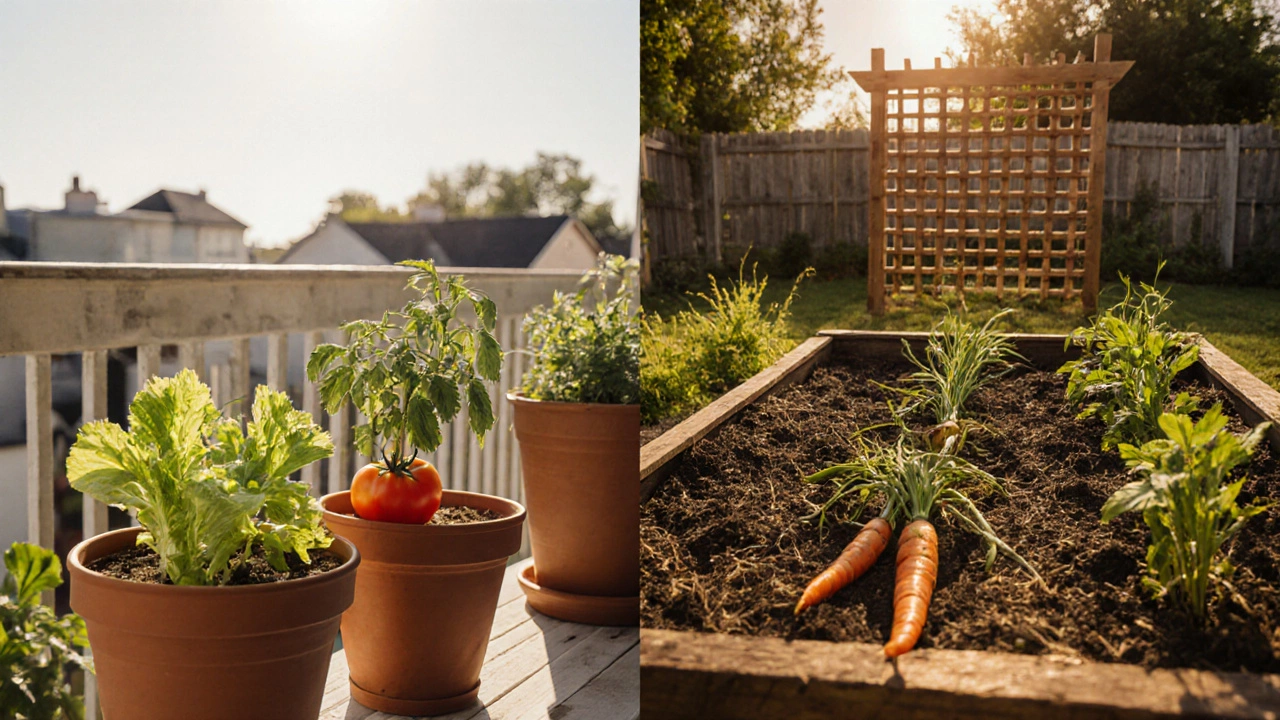Garden Method Calculator
Which Garden Method Is Best for You?
Answer a few questions to find the optimal vegetable gardening method for your situation
Quick Takeaways
- Containers give you full soil control, but need careful watering.
- In‑ground beds use natural moisture and usually produce higher yields.
- Choose based on space, budget, climate, and how often you can tend the garden.
- Both methods work for most common kitchen veggies - just match the right setup to the plant.
- Mixing both can give you year‑round harvests on a balcony and in the backyard.
When you stare at a sunny balcony or a patch of garden soil, the first question is often the same: Container vegetable gardening is a method where you grow your crops in pots, buckets, or any portable container, while In‑ground vegetable gardening means planting directly into the earth. Both have clear strengths and drawbacks, and the “better” choice depends on the jobs you need to get done. Below we break down everything you need to decide, set up, and maintain, whether you’re a balcony dweller or a backyard enthusiast.
Why the Choice Matters
Understanding the core differences helps you avoid costly mistakes. Containers let you move plants indoors when a late‑season frost threatens, and they let you tailor the soil mix for picky veggies like tomatoes. In‑ground beds, on the other hand, benefit from native soil microbes, usually need less frequent watering, and often support larger root systems for higher yields. Your decision will affect water use, cost, space efficiency, and even the types of vegetables you can grow successfully.
Pros & Cons at a Glance
| Factor | Container vegetable gardening | In‑ground vegetable gardening |
|---|---|---|
| Space requirement | Fits balconies, patios, windowsills | Needs a permanent plot or raised beds |
| Soil control | Full control over mix, pH, drainage | Relies on existing soil; amendment needed |
| Water usage | Higher - water evaporates faster | Lower - soil retains moisture longer |
| Initial cost | Containers, potting mix, saucers ($50‑$150) | Minimal - just tools and amendment ($20‑$80) |
| Yield potential | Good for small‑scale, fast‑growers | Higher for deep‑rooted crops |
| Pest pressure | Easier to isolate disease‑infested pots | More exposure to soil‑borne pests |
| Seasonal flexibility | Move indoors for chill or heat | Limited to local climate unless you build a cold frame |
Setting Up a Container Garden
First, pick the right potting mix. A blend of 40% compost, 30% peat or coco coir, and 30% perlite or vermiculite provides drainage, aeration, and nutrients. Add a thin drainage layer of gravel or broken terracotta at the bottom - this prevents waterlogged roots.
- Container size: For leaf lettuce, a 6‑inch pot works; for tomatoes, aim for at least 12‑inch diameter and 12‑inch depth.
- Location: Ensure at least 6‑8 hours of direct sunlight exposure per day. South‑facing balconies are ideal.
- Watering schedule: Check moisture daily. Use a watering schedule that maintains consistently damp soil but never soggy.
Remember to incorporate a slow‑release fertilizer or a weekly liquid feed, especially for heavy feeders like peppers.

Preparing an In‑Ground Bed
Start with a soil test - check soil pH and nutrient levels. Most vegetables thrive in a pH of 6.0‑6.8. Amend the soil with plenty of compost (2‑3 inches mixed in) and, if the soil is heavy clay, add coarse sand or perlite for better structure.
If space is limited, consider a raised bed. Raised beds give you the soil control of containers while still offering the benefits of a larger root volume.
- Bed layout: Space rows 12‑18 inches apart for shallow‑rooted crops (lettuce, radish) and 24‑30 inches for deep‑rooted plants (carrots, beans).
- Irrigation: Drip lines or soaker hoses reduce water waste and keep foliage dry, lowering disease risk.
- Mulching: Apply a 2‑inch layer of straw or shredded leaves to suppress weeds and retain moisture.
Maintenance Tips for Both Methods
Regardless of where you grow, a few universal practices keep veggies healthy.
- Regular feeding: Every 2‑3 weeks, add a balanced organic fertilizer.
- Pruning and staking: Support tomatoes and beans early with stakes or a vertical trellis to improve airflow.
- Pest monitoring: Inspect leaves weekly for aphids, whiteflies, and slugs. Use neem oil or hand‑pick as needed.
- Crop rotation: In‑ground beds benefit from rotating families each season to break disease cycles. In containers, clear the pot and start fresh every season.
When One Method Beats the Other
Use containers if:
- You have limited ground space (balcony, patio, rooftop).
- Your climate has extreme temperature swings - you need to move plants indoors.
- You want precise soil control for picky varieties (e.g., heirloom carrots).
Choose in‑ground if:
- You have a sunny yard with decent soil depth.
- You plan to grow high‑volume crops like potatoes, carrots, or beans.
- You want lower water usage and can invest in a simple irrigation system.

Hybrid Approach: The Best of Both Worlds
Many gardeners place containers for early season seedlings, then transplant them into the ground once the risk of frost passes. Others keep a few containers on a balcony for herbs and quick‑harvest greens while the backyard produces main‑course veggies. This hybrid strategy spreads risk, maximizes harvest windows, and keeps the garden interesting year‑round.
Common Issues and How to Fix Them
| Problem | Likely Cause | Solution |
|---|---|---|
| Wilting leaves | Inconsistent watering (containers) | Install a self‑watering reservoir or use a drip emitter. |
| Yellowing foliage | Nitrogen deficiency (in‑ground) | Side‑dress with compost or a nitrogen‑rich organic fertilizer. |
| Root rot | Poor drainage (both) | Add more perlite to mix or improve raised‑bed soil structure. |
| Pest outbreak | Dense canopy (in‑ground) | Thin plants, improve air flow, apply neem oil. |
Next Steps for Your Kitchen Garden
1. Measure your available space - balcony width, patio length, or garden plot size.
2. Choose the method that fits your schedule and climate.
3. Gather the essential supplies (containers, potting mix, compost, tools).
4. Start with easy veggies - lettuce, radish, and herbs - to gain confidence.
5. Keep a simple log of watering, feeding, and harvest dates. Adjust as you learn what works best for your micro‑climate.
Frequently Asked Questions
Can I grow tomatoes in small balcony pots?
Yes, pick a 12‑inch deep, 15‑inch wide pot, use a high‑quality potting mix, stake the plant, and water consistently. A sunny spot with at least 6‑8 hours of light is crucial.
Do I need to fertilize container vegetables more often than in‑ground?
Generally, yes. Containers leach nutrients quickly, so a balanced liquid feed every two weeks keeps growth steady.
What’s the best way to protect potted veggies from frost?
Move the pots to a sheltered spot (garage, porch) and wrap them in horticultural fleece. A temporary cloche or cold frame works well for short cold snaps.
Should I rotate crops in a raised‑bed container?
Yes. Even though the soil is contained, rotating families each season reduces disease buildup and improves soil health.
How often should I repot my vegetables?
Most fast‑growing greens can stay in the same pot for 8‑10 weeks. For larger crops, transplant to a bigger container or into the ground before they become root‑bound.

